An interview with Dvir Bar-Gal on August, 21, 2024
Expert for the Jewish History of Shanghai
A Chance Find Leads To Two Decades Of Heritage Commitment
“I came to Shanghai from Sri Lanka, where I used to work for Israeli television during the 1990s first as a cameraman and then as the director of short features. I moved to Shanghai to cover September 11, 2001 at which time the Israeli media did not have many journalists in China. So I worked as a freelance journalist, studied Chinese, and during the course of my study, began to take an interest in the Jewish heritage tours run by an Israeli woman at the consulate there, Georgia Noy.
Soon after I met Georgia, she brought me a story she thought would be of interest to Israeli viewers about an antique shop in Shanghai selling Jewish gravestones. At the beginning, I did not think it would be interesting for me as a TV maker – I had previously shot a story in Sofia, Bulgaria, about Jewish cemeteries in bad condition and it didn’t make the headlines in Israel. But then Georgia explained to me that Shanghai used to have four Jewish cemeteries. And later I learned that there were about 3,700 Jewish graves! This was in the late 1940’s at the time of the Chinese Communist Revolution, and none of them exist in the city today. We’re talking about four cemeteries, with close to 4000 Jewish graves all disappearing from the ground!
After China reopened to the west, I would say from the late 1990s to 2000 people started to contact Georgia and they contacted the Chabad rabbi in Shanghai looking for the burial places of their ancestors, yet nobody could tell them what had happened to them, or even what to look for. Georgia and I went to the antique shop, and from there began to explore the story. Our research took us outside Shanghai to Qingpu District, which is today part of the city, but in 2001 was a village area on the outskirts.
There, we started to find and collect Jewish gravestones. People were using them as wash boards, stepping stones and as construction material. Although it was not my intention when I first came to Shanghai, for the last 23 years I have been trying to locate as many Jewish gravestones as I can find. Then with a few grants, I developed a project to collect as many I could collect with a goal of preserving them in a memorial site in the city. 23 years later, most of these gravestones are in a storage facility far from the city and the government still hasn’t given us permission to build a memorial site. So even today, this project is on the go in the hope that one day we will be able to do something more proper with the lost Jewish gravestones that I have found.
Through the process of doing journalistic research into the lost cemeteries, I learned much more about the Jewish history of Shanghai. And then about a year and a half after we met, when Georgia left to go back to Israel, she asked me if I would like to help run her tours. That kept me busy from 2002 to Covid in 2020. Thanks to Imperial Tours and others from around 400 visitors per year that Georgia had when she left, I grew this business almost 10 times the size.
One of the reasons I have come to find the whole story fascinating is because in Israel, the story of Shanghai is completely unknown.
The First Wave Of Baghdadi Jewish Opium Traders to Shanghai (1840’s – 1890’s)
On my tours, I give a lot more information about the Opium War, but in brief, there were three major Jewish immigrations to Shanghai, and the first one was right after the Opium War in the middle of the 19th century. The Brits won over China in 1842 and took small city ports for themselves. Shanghai was one of them. Following that, a Jewish community started to develop, mostly of originally Baghdadi Jews who came via India. They lived in India already, and expanded their business from there to Shanghai. Most of it was based on opium trading. We’re talking about a very small community centred around the Sassoon family, who used to have a huge conglomerate trading between the Far East and England with trading posts from Singapore to Manila to Rangoon in Burma, Kobe, Japan and so on. After the Sassoons opened their offices across the Far East, they started to bring other people they knew from Baghdad or Bombay to work for them, and with that, a Jewish community, mostly Baghdadi in origin, established itself in Shanghai. It stayed small, but very, very rich… very wealthy.
One cannot underestimate how much they contributed to the way that Shanghai developed to be what it is today. Many of today’s landmarks, like the Fairmont Peace Hotel, which used to be called the Cathay Hotel, built by Sir Viktor Sassoon… many of these impressive landmarks are still standing today, but not just these. Even the roads and districts, the main road in Shanghai, Nanjing Road… it’s really hard to underestimate what the Baghdadi Jewish community built. And they were never more than 1000 people.
They built two synagogues. One is Ohel Raquel and one is Beta Haron, of which Ohel Rahel is still standing today. The Sassoon family built it. Beta Haron, unfortunately, was destroyed in 1997. The major names of this community will be the Sassoon’s whom I mentioned before, the Kadoorie family, who still exist with big businesses in the Far East (including the Peninsula Hotels), maybe the only Baghdadi Jewish family from this wave that still impacts the Far East. There was also the Hardoon family, the Sofer, the Ezra, the Abraham family. We’re talking about the movers and the shakers of Shanghai in the late 19th and early 20th century.
Second Wave Of Jewish Immigration Was From Russia (1890’s to 1930’s)
In the early 20th century, there were so many good reasons for Ashkenazi Russian Jews to emigrate as soon as they could. An official program of antisemitism came from the Tsar himself. He forced many of the male Jews from the age of 14 to serve in his army. Many of them, if they did not shoot themselves in the leg to avoid conscription, tried to emigrate to other countries. Soon after came the pogroms in the Vale of Settlements and in all the shtetl and so there were a lot of good reasons for Jews to leave Russia. They went all over the world, to South Africa, to England, to America, but they also came to China.
When they went to China, they did not need to take any boat. They came over the trains on Siberian railways from the west to the east, and then either directly or via the city of Harbin in Manchuria, where there was also a large Jewish community for a time, they took trains down south to Shanghai, which soon developed to be a cosmopolitan city in the early 20th century. The Russian Jewish community grew between the 1890’s to the 1930’s to almost 6000 people. That was 6 times more than the Baghdadi community. And obviously, as soon as they grew in numbers, they opened their own establishments.
They opened their own synagogue, and as happened everywhere in the world, they lived apart from the Sephardi Jewish community. They had their own life and culture, etc. Many of them moved into apartment buildings in the French Concession. The wealthy Baghdadi Jews, if they lived in the French concession, lived in big mansions, but the Russians lived in nice apartment buildings. Although some had small shops, they were less into business and more into the professions, so many of them were doctors and lawyers and teachers and writers, musicians like the head of the Philharmonic of Shanghai.
I would say that if they can claim to have helped the development of Shanghai, that this would be in these types of occupations: in education, medicine, culture and so on. Shanghai is famous for both jazz and classical music, and many of the early 20th century Chinese musicians learned their skills first from the Russian Jews and then from the third community that we will come to discuss, the musicians from Austria running away from the Holocaust.
The Third Wave – Jews Fleeing The Holocaust (1938 – 1942)
The third Jewish community was in Shanghai the shortest time, eight years on average. That’s all, but they make the story of the usefulness of Shanghai more known today. We’re talking about a big group of refugees that arrived in Shanghai just before and during the Second World War. The third wave starts from the Kristallnacht (Night of the Broken Glass – an overnight pogrom in Nazi Germany and Austria) in November 1938 until ‘42 so arriving within three or four years and staying until after the war and the communist revolution.
This third community peaks at the height of the war in Europe after the Final Solution, the extermination of the Jews, has already started. They come from Germany and Austria mostly, and later from Poland. There were also some Hungarian Jews and some Czechs, but it was mostly a German-Austrian immigration. The reason why they arrived from Europe was, obviously, that there was antisemitism there. And the second reason is that there were no other places in the world that would admit them in those days. Countries had their own waters and restrictions, and they didn’t want to accept Jewish immigration.
The Righteous Gentiles (Non-Jews Who Helped Jews Escape The Holocaust)
Chiune Sugihara
I don’t want to get into it in depth here. You have to join a tour for that, but there are some Righteous Gentiles in this history – mostly diplomats – who supported Jewish people leaving Europe, and their route brought them to Shanghai. One of them was a Japanese Consul, Sugihara, a Japanese person in Kovno, Lithuania, who issued more than 2,100 “laisser passer” – not visas – but transit papers. They permitted Polish Jews, who had run away from Poland to Lithuania, to go to Russia and take the Trans-Siberian Railway all the way to the east, a week-long journey, and to cross from there to live in Kobe in Japan.
Before Pearl Harbour, the Japanese government was not in favor that these foreigners should come to them and they actually cabled Sugihara twice to stop, but he kept doing that. The Japanese did not want these foreigners and the people helped by Sugihara had to leave Japan, and most of them, not all, but most of them arrived in Shanghai. After Pearl Harbour, more or less the last group of Jewish people who came to Shanghai were the people who came with Sugihara papers, and we are talking about a few thousand of them.
Dr Feng Shan Ho
Another Righteous Gentile was Dr Ho, a Chinese consul in Vienna, Austria. He also issued a few thousand transit papers to allow mostly Viennese Jews to leave Austria. They did not take the train to Shanghai, but went down to Italy. The vast majority of these immigrants came in 1937-38, right after the Kristallnacht, and went by train to Genoa and Trieste in Italy, and from there they embarked on ships. They went on the Mediterranean Sea, passing the Suez Canal. The ship stopped in many ports in Asia, like Manila, Singapore and Hong Kong, but the Jews were not permitted to stay in those countries. So the ships docked in the one open port, Shanghai, where everyone could come in. If you had a ticket on a boat to Shanghai, you were free to walk in. When the people in Europe realized that, although Shanghai was not the dream of any Jewish person in Europe to emigrate to, when they realized this is one place they can go to and they had no other choice, many of them started to seek a way to Shanghai. The total immigration of this third wave is about 18,000 Jewish people.
Penniless Jews Arrive In Shanghai During The War
When many of these people left Europe they were permitted to take with them only 10 Reichsmarks. They had two suitcases in their hands and 10 Reichsmarks in their pockets, which was about three and a half dollars. That was the amount of money the Germans allowed them to leave Europe with. We’re talking about people from the middle class of Europe, doctors and lawyers and engineers – the type of occupations that Ashkenazi Jews occupied in Europe in those days. They all became extremely poor the moment they touched the ground of Shanghai looking for a place to stay.
The Jewish communities and organizations already in Shanghai tried to deal with this situation. They tried to find communal housing for them, to register them properly and to give them support until they could find work and rent somewhere or until they could move them to another shelter. They had a soup kitchen and other daily support to keep them alive.
You can only imagine the chaotic Shanghai they were moving into: Chinese poor mostly, and rain, and the heat of the summer, combined with invaders from Japan at that time, soldiers and others, and with many other foreigners, from the French in the French concession, Russian immigration, all the Portuguese, Spanish and the Italians that were in the city, and now you have these people with no money at all who needed to start their life from scratch in an exotic, wild city like Shanghai. You can imagine the culture shock and the economic gap.
Japanese Herd Some Jews Into a Kind of Ghetto
A few years later, under the influence of the Nazis, the Japanese, who occupied Shanghai, published a proclamation. It came in February ‘42. This proclamation stated that all the stateless people of Shanghai who arrived after 1937 must move to live in a certain area that they called by the name of the streets. It’s called the Hongkou district today, a poor neighbourhood by the river, a neighbourhood of immigrants and poor Chinese. The Jews who came after ‘37 had to live in this neighbourhood without the ability to be in other parts of the city.
Many people immediately think that this was a ghetto, and it was a ghetto but nothing like what we know from Europe. First of all, the Japanese proclamation referred to stateless people who came to Shanghai after 1937. All the Russian Jews, the Baghdadi Jews or any of the Ashkenazi Jews who came to Shanghai before 1937 were not forced by this proclamation to live in that neighbourhood. Also, it was not a ghetto because they never built a wall around it. If you were caught without proper papers in other parts of the city you would get in trouble. That was the essence of it. There were Japanese soldiers at checkpoints all over the city where you needed to show papers, for example to cross the garden bridge into Hongkou, and if you didn’t have the right papers you shouldn’t be there.
They had to stay in the neighbourhood but within it they could keep life going which meant that if you came early you might open a barbers’ or a tailor’s shop or a bakery. It was actually called “little Vienna” in Shanghai because there were so many Viennese-style coffee houses, opened by German Austrian immigrants to cater to everyone beside Chinese, because the Chinese did not sit to drink Viennese coffee and eat strudel. They hoped that other foreigners would come to enjoy their strudel. However, their own community could not afford to eat strudel. They were really poor to the end of the war.
At the height of this period, there were 25 – 30,000 Jews in Shanghai in Shanghai in those days.
Jews Leave After The War
The Americans dropped the bombs in Hiroshima and the Japanese surrendered. For a while, after the Americans came with their ships into Shanghai, they asked the Japanese forces to keep order so that there would not be chaos in the city, but that was only for about 10 days or two weeks. Right after the Americans took control of Shanghai, they started to give jobs to anyone who could speak English. Many of the more educated refugees who could speak English were able to earn ten times what they were making before.
Soon after, China fell into a civil war and people started to realise that Mao Ze Dong and his people were taking more parts of China and so the Jews started to leave. The first to leave were the refugees who came the last, because they had never really seen Shanghai as their home. They had run to Shanghai because they had no other options, and when other options started to open, mostly America and Australia, as soon as they could get visas they would leave. The Russian Jews who had small businesses didn’t want to start somewhere else but they knew Communism from Russia and they definitely didn’t want to stay under Communism and so at about the time of the Chinese Communist Revolution the majority of the Russian and the Baghdadi Jews had left.
I would say that by the time of the Communist Revolution in 1949 about 80% of the 25,000 Jews had already gone. Then, it all dissolved in 1952. Ohel Rachel, the synagogue that the Sassoons built was active until that time, and then the Communists put a picture of Mao Ze Dong over the Jewish ark and sealed the doors because they were against religion. After that, there was almost no Jewish Community.
To be exact, there were still some people living there in 1957. When they published a small community booklet at that time, there were about 70 people. So, within about 9 years, a community of 25,000 was reduced to 70 people. The Joint Distribution Committee contributed some money to who was left. These were mixed families of Chinese and Jewish people, but by the 1960’s there were only about 3 Jewish people still in Shanghai and the community had ceased to exist.
So the Jewish story in Shanghai is short, from the Opium war in 1842 to the Communist Revolution in the 1950’s, so 110 years – that’s a brief history of the Jews in Shanghai.”
Travelers interested in an extensive walking tour, covering this history, should contact Imperial Tours.
1. What does the Michelin star mean in China and what does it mean to you?
Michelin of course creates and sets the standard for fine dining experiences worldwide. As Temple Restaurant Beijing (TRB) has always aimed to provide the best fine dining experience in Beijing, it was crucial for us to be recognized for what we do. I am delighted that an equivalence has now been drawn between Beijing’s top restaurants and the dining in other leading gastronomic centres of the world. We can argue about the details, but the larger point is that this puts TRB on a global map.
2. How have Chinese tastes in fine-dining changed over the time that you’ve been a restaurateur in Beijing?
When I arrived in Beijing, there were a handful of western dining venues and none of them charged more than $40 a head. The market is now bursting with dozens of western restaurants and Temple Restaurant just got through Covid charging more than $160 a setting. Twenty years ago, a western meal in Beijing consisted of a Shiraz paired with a well-cooked steak. If you were lucky the waitress put the right plate in front of the right guest, and even that was a challenge. Now, we offer the same dining experience you’d find in London or Manhattan. Our ingredients are global – foie gras from France, caviar from Iran, A5 Wagyu from Australia, and our cooking techniques marry the most skilled techniques of east and west. Have things changed? It’s incomparable. Only in China can things move that fast.
3. Has the quality of restaurants changed in China over that period?
The wealth of Chinese clients, who these days, return from holidays and business travels in all corners of the globe, and indeed China, has created a really enterprising restaurant culture. But it is not for the weak or faint-hearted. There are no laws protecting tenants and as I don’t speak Chinese, I am often signing contracts based on nothing more than trust. Some would call me naïve, but after working here for over 20 years, opening many restaurants and with a degree of success, I think I have learned well enough how things work. It’s a challenge that also gives a lot back. Back to your question – 20 years ago, quality was mediocre in every area of Chinese gastronomy outside the top hotels from the quality of the food, to service to technical skills, to front of house to the décor to technology to the overall experience. It was poor compared to the highest international standards, many steps below what I provided at the Dorchester for example, but I similarly cannot over-emphasize how much that has now changed. China is competitive now, but we are competing up and the fashions that we set are being replicated in other countries. Technology for example from online menus, to offline menu booklets to payment systems. I now see some things happening China that over time filter across to other countries. It’s an exchange. Meanwhile, restaurant choice, quality and concepts rival the international standard in many of the obvious ways. Because of their native interest in gastronomy, the Chinese client is as knowledgeable and discerning as a French or Italian, even though the tastes and techniques might be different. What has amazed me is how open they are to new experiences. For example, there are concepts that have succeeded in Beijing that I don’t think could survive elsewhere.
4. What excites you about China now?
Apart from Temple TRB, which is my flagship, I have about a dozen restaurants operating under different concepts. I love rolling the dice on a new concept and when it works there’s the opportunity to expand across the city and nationally. My particular challenge is learning how I can grow my network of businesses profitably. Quality is part of my blood, and so operating in lots of venues where I can’t personally be present while insisting on the delivery quality I would expect is what sets our restaurants apart. It can take months and years to build a restaurant, but it only takes days for all that hard work to fall apart because of poor execution. That is the knife edge on which I live. Apart from TRB and my chain of Belgian style cafes with snacks and salads, western guests would be interested in “Fork” in Beijing, offering high quality western food at about $100 a head and also in “Jamon”. This is my Spanish restaurant. Who knew that Chinese LOVE Spanish food? Touch wood, its success keeps growing, but I hope western visitors would love to try all of my restaurants.
5. Anything else you want to say?
China has of course changed so much over the Covid period. Some of it good and some bad, but what hasn’t changed in Beijing or indeed in China is the speed of change itself. That is a constant and it’s why I love being here with my wife and kids. We stayed through Covid and have no plans to move – it’s our life. Yes, China has an unrivalled past. My TRB is housed inside a Qing dynasty temple, for example. But for my kids… if you want to glimpse where the world is going, that’s here too now. That’s why visitors should come and eat at my restaurants!
24 years ago I co-founded Imperial Tours, an inbound luxury tour operator in Beijing where I lived for 20 years. As a result of Covid, I was trapped outside China from November 2019 until three weeks ago when I returned for the first time. This article describes my experience of how China has changed during Covid.
The Status Of Westerners In China
I first moved to Beijing in 1997 to study Chinese at Beijing Language and Culture University. It was such a fun place to be. As a Caucasian it seemed as though I had a free pass to go anywhere and do everything. A Western junior diplomat of the time, now senior, used to joyfully drive us the wrong way down one-way streets for the sheer fun of it protected by diplomatic immunity. That was the atmosphere.
Unknowingly, I was benefiting from a century-old, unspoken social hierarchy topped by Westerners. But this unearned assumption of superiority took a grievous blow after the great recession of 2008 – 09 when the greed of western bankers wrecked the global economy. This not only exposed endemic institutional corruption but also shredded the reputation of the western capitalist model for probity and global governance.
And together with the successful rise of affluent Chinese – people who’d been born to nothing and had worked hard to afford their luxury lifestyles – the social pecking order within China began to change. One day soon after, I recall walking into the Bentley showroom with my American wife to find the sales person hop, skip and jump straight past me to a shabbily-dressed young Chinese man walking in behind – and sadly, this was entirely astute.
Three weeks ago, standing in the lobby of the Four Seasons Hotel, a place that would have intimidated many two decades previously, I could not help but be impressed by the swaggering self-confidence of the fashionably dressed, coiffed and shoed, local clientele. I realized with sudden clarity that I was the only hotel resident in the room not wearing a designer label, and also that in a room full of Chinese strangers, people who’d built their status-driven identity on such values, this did in a way matter.
While the Four Seasons hotel lobby represents only the commercial elite of Chinese society, I can draw a direct comparison for this group over the years. On that basis Chinese people in urban centers have progressed immeasurably and significantly matured such that the relative status of Westerners has dropped relative to them.
A Countryside Transformed
Whilst there’s a measure of disaffection in the cities, in the countryside I found a diametrically different story. Country folk have benefited mightily from the government’s decade-long “Poverty Alleviation Campaign”, the biggest and most unreported development in China over the last 10 years.
If the former leader Deng Xiao Ping set off the economic reform process in China with the aphorism “To get rich is glorious”, then Xi Jinping’s mantra of “the harmonious society” has been all about pulling up the countryside by its water-buffalo straps and reducing the wealth gap with the cities. This transformation has been staggering.
As a longtime China resident, I had been expecting to see litter, polluted water, wasteland, poorly built dwellings and a weird social mix in the villages of elderly grandparents with their grandchildren, the middle-aged parents having all left for manufacturing centers in search of work – those were my expectations of China’s countryside.
On returning to China after Covid, I could not have been more surprised. Traveling by high-speed train from Beijing to Xi’an, I saw a country networked with raised rail-tracks and highways traversing well-tended fields before a backdrop of townships with the odd kempt village. Traditionally, the poorest villagers in Shaanxi lived in cave dwellings – couldn’t find any of those anywhere near Xi’an now.
When I traveled to villages in southern Guaanxi province, an area admittedly in the top tier of China’s rural areas, I was flabbergasted by the changes. Ian Hamlinton, a South African architect, cum country hotel entrepreneur, cum Chinese TV personality, told me how Chinese villages have been revolutionized over the past decade.
“The government has invested in public services like sewage systems, piped water, a secure electricity supply, rubbish collection systems and you’ll even see publicly funded irrigation. Farm machinery has replaced the water buffalo, freeing up the afternoons as they don’t need to graze the buffalo anymore,” he related.
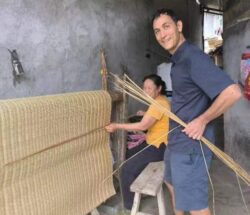
Reed mat weavers appreciate new health insurance coverage.
With their accommodation paid for and government support for health and education, they just need to make a little cash to get by. As a result, the villages are bustling again. The countryside has been so transformed to my eyes that I wonder how the traditionally parsimonious Chinese government is planning to fund these major reforms given the financial challenge set by the poorly performing economy.
Xi’an, The Shanghai of The West
As a result of the louche and excessive debauch in its French concession, Shanghai became known as the “Paris of the Orient”. It was an anything goes kind of place as the Chinese city of jazz partied into the early dawn of the twentieth century. This tag-line was used to market it in the 1980’s, but whilst Shanghai preserves and enjoys its Art Deco period, many voices in China’s elite have urged Shanghai to move on as a symbol of Chinese modernity. The incredible Lujiazui cityscape is an apt metaphor for what China and Shanghai have achieved over the last 40 years.
So when a couple of weeks ago I was driven from Xi’an North railway station across town to the Ritz Carlton Hotel to its south, I very much wondered how I’d somehow ended up in Shanghai. Had I taken the wrong train and arrived in Shanghai instead of Xi’an by accident? Where was the dirty, destitute city of Xi’an with its narrow roads and air pollution – the place that tourists in the early 2010’s would jet into in the early morning to see the Terracotta Warriors first thing so that they could fly out again immediately after and therefore largely avoid. I couldn’t find it anywhere.
Instead, I was in this sparkling new place speeding along a fabulous raised highway overlooking beautiful trees and passing modern apartment blocks that went on for miles and miles. It was the most befuddling sensation. What had happened? But that is China.
And for a provincial Limey like me, it feels like China’s the only place it could possibly happen like this. I must admit I’ve seen Austin, Texas blossom over the last 15 years, so I am aware of how growth happens in the west, but this is on a completely different level. It’s like another universe.
By way of rational explanation, I should explain that Xi’an is close to President Xi Jinping’s hometown and so just as Shanghai benefitted massively under the leadership of Jiang Zemin, who was from there, so has Xi’an these days benefitted from huge recent investment under its current leader.
Those of you who think you’ve been to and know Xi’an, think again – it’s bigger, newer and altogether more marvelous than you can possibly imagine, and as it’s got more archaeological treasures buried in its ground than any other place bar Luxor, there’s plenty for travelers to do here. I visited the new archaeological museum, and there’s plenty of other cultural sites like Famen Temple or the Tang dynasty frescoes for people to enjoy over and above the Terracotta Warriors, city wall and Muslim quarter.
What’s Not Changed In Hong Kong
This leads us finally to what’s happened in Hong Kong. Following the tough response to the umbrella movement and resulting sanctions, there is no question that a lot of western multinationals and expats have moved their businesses out of Hong Kong, often to Singapore, which has profited mightily as a result. I also caught the tensions that persist between mainlanders and local Hong Kongers, which most recently flared in the controversy over the behavior of Hong Kong Cathay Pacific flight attendants towards their mainland Chinese customers.
Nonetheless in my stays at the stalwart Mandarin Oriental and Peninsula Hotels I found the age-old and enduring values of world-leading hospitality predominant and well-sustained. Indeed, I was tickled pink to see longtime Peninsula servant Rieko Kibo in the lobby greeting guests. There is a savoir faire and sophistication embedded within the fabric of Hong Kong that helps it transition effortlessly between cultures.
Although there is a feeling that Hong Kong needs to confront the concentration of power in its property owners, friends inform me that the gap left by multinational company departures is being filled at least partly by a vibrant new class of entrepreneur from a more cosmopolitan background, particularly from the Middle East and Latin America. Development plans for the Greater Bay Area, also spur optimism.
Just as when I first visited China in 1993, there remains the feeling that China is a place on the move. The raw power of the place is still inspiring when you go to cities like Xi’an and see it entirely transformed, or find that over a three-year period, the countryside is so improved. I was proud, happy and fascinated to see those changes, though of course disheartened by areas where China seems to have moved in an unattractive direction.
People talk about the increased surveillance and the regular flashes of traffic cameras on the roads did disturb me. On the other hand, the first use of facial recognition software on this trip was introduced by Lufthansa and the British border force for flight check-in and immigration in London before I got anywhere near China. What was best about this trip though was the opportunity to meet up with so many old friends and be back doing something I love.
First published in Insider China Report on June 14, 2023.
During these times when our faith in the future is questioned, it’s uplifting to be sent glimpses of societies that are further ahead in confronting Covid-19. China and Hong Kong had the misfortune to face their first coronavirus in November 2002. That gave them a head start in meeting the challenge set by this new disease. Kate, Imperial Tours’ Shanghai-based China Host, provides a snap shot of life in Hong Kong and the main cities of China’s mainland. She explains the technology and history underpinning their relative success in confronting Covid-19 and provides peace of mind by showing how – even before there is a vaccine – we can establish a new normal.
When Covid-19 first attacked, it appeared that Hong Kong was at great risk and likely to become inundated with cases. It has many land borders with the mainland and a huge influx of visitors crossing its borders every day, not to mention it being a transit hub for international flights from all over the world. Yet a lockdown never became necessary in Hong Kong. Why? Because Hong Kongers have been here before. These are people that have come through SARS and swine flu and they know the drill. So without the need for laws and lockdowns and police, the Hong Kong people started distancing from each other. They wore masks when they went outside and chose to stay home more. A survey in March found that 85% of people said they were avoiding crowded places, and 99% said they wore a mask if they went outside.
The government supported this effort by acting quickly and following WHO guidelines to test, test, test. They allowed just three crossing points from the mainland to remain open and introduced strict checks and quarantine measures for those arriving in the city. They stopped flights transiting. They also limited gatherings to a maximum of four people and required restaurants to separate tables and limit capacity to 50%. Bars and nightclubs were closed for a time, generally just 14 days. So, restaurants didn’t close, nor did daily life shutdown, yet with the willingness and cooperation of a people quick to play their part, Hong Kong maintained one of the lowest case-counts of the virus in the region.
At the time of writing, Hong Kong’s borders with the outside world remain closed to outside visitors and some restrictions remain in place. For example, it’s common to have your temperature checked and to see plastic screens separating tables in restaurants. However, people are gradually feeling safe to meet, now in groups of eight, as per current guidelines. Bars, beauty parlours and other leisure facilities are reopening and life is getting back to normal, albeit with the continued use of masks
At this point, bars and restaurants have reopened and patrons need not wear masks. In fact, only on public transport and in office buildings are masks widely worn indoors. Cinemas and other cultural events are operating at reduced capacity and if you fancy a swim you’ll need to book in advance. However, within those parameters, life is largely back to normal. Schools are slowly opening, people are travelling to work and socialising in the evenings. It appears China’s major cities have reached a new normal.

All residents use a QR code within Alipay or Wechat (If you haven’t heard of these platforms, you will have within five mnutes of arrival in China, it’s pretty much impossible to function on the Mainland without them. Think WhatsApp or Facebook but so much more necessary.) The system is pretty straightforward, you sign up with information about your health and where you’ve recently travelled. Then everywhere you go you scan the QR code, for example on a metro carriage or in a mall, and as a result of this you get given a traffic-light-based colour-code. A green code is your passport to freedom! Bars, restaurants, malls, whatever, you just show your green code at the door and in you go.
Now, it is worth pointing out that each city operating these codes has a separate system so the criteria and consequences differ slightly, but broadly speaking, if for any reason someone you’ve been in contact with later tests positive for the virus, your code turns yellow, at which point you’re required to self-isolate at home. You won’t have much option because with a yellow code no-one will let you in anyway. If you yourself develop symptoms and test positive, your code becomes red at which point you need to be in a government operated isolation facility. This method seems to be hugely effective, probably because of it’s ease of use and the willingness of the public to subscribe. The local transmission of cases has fallen to basically zero in all of the major cities. A secondary reason this system may be so effective, is that it makes a green code so valuable, that no-one wants to risk losing it. Therefore, the incentive to take unnecessary risks is reduced significantly
China has weathered an array of health crises since it’s opening up in 1979. From the Hepatitis A outbreak in 1988, to the much publicised outbreaks of SARS in 2002/03 and H7N9 in 2013 and now, the worldwide pandemic we all face. Yet as the virus persists and spreads from one hotspot to the next around the globe, in China, where the eyes of the world were so focussed just four short months ago, life is pretty much back to normal. That’s not to say there isn’t the occasional small outbreak, quickly contained and dealt with, or that people don’t remain cautious, but on the whole, the economy is moving, people are working, leisure venues are open and China is back.
So how did a country faced with a virus unprecedented in its transmissibility regain control in such a relatively short space of time? In short, the preparedness of the authorities and the willingness of the people.
The virus was widely recognised mid-January, shortly before the Chinese New Year holiday. This may have been a blessing in disguise, as, although huge numbers of people travel for the week long holiday, it made it relatively easy to close workplaces. China’s first line of defence was to lockdown Wuhan city, where the virus originated, closely followed by suspending intercity travel and extending the new year holiday in order to stop people moving around, taking the virus with them.
Increasingly strict measures followed nationwide. Neighbourhood committees (local “police” in charge of each residential area) became extra assertive, especially in Shanghai, where the rules imposed by the neighbourhood committees frequently went further than the national government guidelines. In Beijing, residents were advised to tell their local authorities of their impending return whereupon they would be asked to self-isolate for 14 days. In Shanghai, people could only sleep at the address at which they were registered and could not enter other apartment complexes for any reason. Masks became compulsory when leaving home, something which was only permitted for the purposes of buying essential supplies. Once the borders closed, anyone arriving at Chinese airports were subject to a mandatory quarantine, often in a designated hotel at their own expense. Those that were allowed to quarantine at home were escorted. As they walked from the vehicle to their home, teams in hazmat suits followed, spraying the ground behind them with disinfectant. Temperature monitors were placed on the returnees’ beds to check for a fever while they slept and sensors were placed on the front door of the apartment. If the door was opened for any reason the returnee would receive a text message asking for an explanation.
Extreme measures? Definitely.
Draconian? Probably.
Successful? Undoubtedly.
Just four months later, with its borders closed and rigorous testing in place, China is back in business.
– Kate is one of Imperial Tours’ China Hosts and a Shanghai resident.
(You can read an English translation of this article here)
因得知疫情有逐渐蔓延的态势,离除夕还有两天的时候我和丈夫决定退掉除夕上午的火车票及取消和外地公婆春节团聚的计划,这个春节假期我们一家三口就继续留守北京度过吧。整个春节除了和同在北京的父母和姐姐一家聚餐外,不能去餐厅商场,没有走亲访友的聚会,想要专注的过个放松散漫的日子吧,却也常常“走神”关注疫情发展动态,武汉医院里那些非同寻常的医患事件牵动人心,悬着的心何时落地呢生活还要继续。得知市政府鼓励企业员工居家办公、暂缓开展全面复工的消息,我和丈夫觉得这7*24小时的居家工作带娃的生活模式还不知会何时结束,那么就先将散漫的春节假期生活作息逐步回归正轨吧。
五岁女儿倒没有早上睡懒觉的习惯,但白天几乎不出门又如何能在家消耗掉旺盛的精力进而晚上早入睡成了我和丈夫经常聊起的事。家里的蹦床没了新鲜感不跳了?那就饭前轮流陪她一起蹦能玩更嗨。孩子喜欢模仿大人做事?那我和丈夫跟着平板电脑里的运动app做瑜伽和跳操呗。后来丈夫更是找来尘封了几年的Xbox,其中的舞蹈滑雪等体感游戏成为晚间全家的娱乐项目。孩子这样就能充分放电天天早睡觉了么?不,你想都别想。好吧晚睡只要不影响白天好好玩耍就好,我们只能这样安慰自己。
经过和女儿快两个月的磨合,白天她扎堆在自己的乐高小猪佩奇和娃娃的世界里,为它们创建有主题和新意的场景,安排人偶各自的角色就能沉浸其中专注玩一个多小时。在玩疲乏或和娃娃生气发脾气的时候,水果小零食就拿出来救救场。免费网络幼儿在线课程及新购入的手工材料书画颜料等也穿插到生活其中。孩子玩得舒心,大人也能趁时机做些自己的事。这么多天的“无处可逃式”的相处下来,亲子关系总体还算是”母慈子孝“,这个基石奠定好了,我和丈夫更能顺利安排好居家的工作。
春节时期和丈夫常聊起的病毒及疫情的话题也自然都逃不掉女儿的耳朵,有媒体制作出了病毒科普动画也找来给女儿观看并讲解。逐渐的,她知道了为什么假期会延长那么久而自己不用去幼儿园,爸爸为什么在家用电脑开视频会也是上班;为什么不能再去隔壁的小区找同班小朋友玩;为什么快递员叔叔不能再送货上门而是要大人们下楼到小区于管控期间唯一的出入口取走快递;为什么不能再和妈妈一起去超市亲自去买想吃的零食,而听说超市门口还有穿防护服的叔叔给大家测量体温后才能进入;更会突然说“妈妈,我也希望你是医院里给人看病的医生可以么。”女儿幼儿园前不久组织的“防疫小卫士”绘画活动,女儿上传的作品内容是妈妈在厨房做好吃的馅饼、我吃了能增强抵抗力。
现在已是中国农历“春分”的时节,白天的室外天气早已是暖风拂面夏天将至的感觉,小区楼下玩耍的孩子们也逐渐增多;周围也有餐厅逐步开放营业,相信这种24小时居家生活状态和快就会结束了吧。
““One hundred and ten!” one of my neighbors yelled proudly from our shared common courtyard. He had been walking around the inside perimeter of our block of flats for the better part of an hour, phone in one hand and a leash connecting him to his sluggish corgi in the other. Face covered with the now obligatory mask, he walked over towards another dog-neighbor duo sitting on a bench enjoying the spring sun and in his booming voice announced he was increasing his loops by 10% each day. The neighbor didn’t bother to mutter a response, and the man’s corgi, unimpressed, quickly slumped alongside his fellow canine.
I am ignorant of what constituted my neighbor’s exercise routine before Covid-19, but Beijing has implemented such restrictive measures on movement that most people are weary to leave their homes except for pressing reasons. Having lived in the historic center of Beijing for almost ten years now, the changes have been unlike anything I’ve ever witnessed. The maze-like hutongs (alleyways) used to have shoulder-to-shoulder crowds of people flocking to the restaurants, bars, shops and tourist attractions of the area. These are now all sealed off with a retractable fence at every possible entry point and manned day and night with at least two, typically middle-aged, volunteers. Working in shifts of two hours, they are armed with a walkie-talkie, a laser thermometer and, most importantly, a sense of duty for collective action against a common enemy, this new virus. A large percentage of restaurants and bars remain closed, and anywhere which may be a focal point for crowds has been shut. The main exception is public parks which, to the relief of many, have kept their doors open to visitors so long as they don a mask and agree to a temperature check.
Although these measures were greeted by skepticism around the world when they were announced, the numbers should be enough to placate doubts of their effectiveness. The early days of February when thousands of new cases were being diagnosed on a daily basis are now unthinkable, and the trickle of cases that continue to emerge -outside the epicenter of Hubei- are mostly imported by travelers returning from one of the other large clusters around the world. As of this week they are being quarantined in specially designated hotels, so while they are mostly returning residents and not luxury travelers to China, measures like this will affect travelers for some time to come. Nonetheless, the drastic downward trend in cases is a welcome respite from the early days of the virus spread, and countries where the virus still looks to be gaining momentum should get some reassurance from it.”
You can now read Part 2 for a follow up of Jaime’s experiences living through the quarantine in Beijing.
– Jaime is one of Imperial Tours’ Itinerary Designers and a Beijing resident.
Since Confucian times, the Chinese have long been a male-centredsociety. In marriage, women typically wed into a husband’s household – more a contract between families than two individuals – and subservience was expected. In such a patriarchal society, by contrast sons were sole beneficiaries to a family’s fortune, and highly revered. Indeed Confucius himself was said to opine that “a good woman is an illiterate one” and, education for girls was thus limited to being a virtuous wife and a good mother; to obey the “Three Obedience’s and Four Virtues”. It wasn’t until the late Qing Dynasty, upon turn of the 19thcentury, that an effort to establish girl’s schools took place. After all, a stable home leads to a stable nation. Then, through China’s more recent history under the Communist Party, we saw further progress toward female empowerment and embracing the role of women. In fact Chairman Mao once declared that women “hold up half the sky”, and the years since have seen significant improvements to a woman’s legal and social status. Demographically, Chinese women have seen vastly raised levels of education, healthcare, employment, and most importantly independence. Since Deng Xiaoping’s program of ‘Reform and Opening Up’, some four decades ago, we’ve seen a sizeable emergence of “nv qiang ren (女強人)” – or “Alpha Females” – and according to the annual Hurun China Rich List in 2018, China now accounts for 63% of the world’s most successful female entrepreneurs.

Zhou Qunfei, founder of touch screen maker Lens Technology
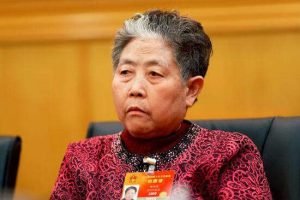
Tao Huabi (or ‘Old Godmother’)
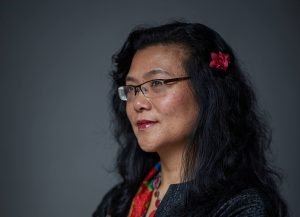
Lijia Zhang ‘freedom fighter’
Whilst travel companies typically extol monuments of the past, China’s attractiveness as a destination extends to its impact on our children’s future. For the past few months we have been looking into the folds and contours of China’s evolving landscape. Previously we looked at the revolution in smart phone apps and payment systems, at leapfrogging technologies in retail and at the development of Artificial Intelligence. Expanding upon the concepts of future, we sat down with Will Beloe, a Global Product Specialist at the International Finance Corporation (IFC), an arm of the World Bank, to discuss China’s approach to the environment. Will has been covering China for nearly two decades and for the last five years has been responsible for driving green investment in financial institutions in developing countries across Asia, including China.
Guy: Why do you think China is taking environmental issues so seriously? Is this a national or global concern?
Will: China is taking its environmental issues very seriously primarily because the country’s narrow focus on economic growth over the last 30 years has pushed its ecologic system to a breaking point. Anything between 3-9% of GDP is lost to pollution (air, water and soil) per annum. China’s government knows all too well that it has an obligation to protect its people from such harm. Climate change is a layer of costs and risks on top of that.
Guy: Are there any areas of green growth where China is leading the world?
Will: China makes 2/3rds of the world’s solar panels and nearly 1/2 of the world’s wind turbines. China had more battery-only electric car sales in 2016 than the rest of the world combined. 1 million Chinese are employed in its solar sector.
Guy: In what areas of climate change is China contributing to a global solution?
Will: China is driving green growth for two reasons – it has tot clean up its soil, water and air, particularly in its mega-cities; and because it is now a market leader in many of the areas. China is beginning to stand tall in areas including green finance. The work IFC has done with local financial institutions (FIS) has led to a reduction in emissions over 50 million tons of greenhouse gasses PA. This is more than our work with other FIS around the globe combined.
Guy: In your field of endeavour how well does China integrate its work with other countries?
Will: Under Xi Jingping, China is no longer 韬光养晦 (hiding one’s light under a bushel). China has bid its time beautifully on the emerging green economy and is now leading the world in many areas, such as those already listed above. It is likely to do the same in the carbon markets (this will take a few more years), in clean green cities, in water management etc.
Guy: In what areas is China a threat to the rest of the world environmentally and in what areas is it a force for the good?
Will: Depends on whether your glass is half-full or half-empty. China is facing some of the world’s biggest problems when it comes to pollution (second only to India). Given its recognition of these threats and the position the government is in, it has the potential to solve these problems in a way that most other countries could not. The solution it implements will do more than most to help put us on track to avoid the worst climate change scenarios, and it will provide a hugely valuable template for others to follow. There are complaints of China dumping solar panels/wind turbines and in the future probably electric cars in other countries. In the end, how bad is that for the world?
Guy: How do you think China could improve in its interaction with multilateral organizations in the area of environmental research, policy formulation?
Will: It has been stymied in its attempts to grow its engagement with already established multilateral organizations. As a result, it ahs ended up establishing a number of its own. Net net, this is likely to be a positive for all but the incumbents.
Guy: How do you view the future of China’s environment and the impact China will have on the earth’s resources and environment?
Will: I am optimistic that China will manage to deal with its population and climate problems faster than almost all other countries will and could. By doing so, it will provide leadership and a roadmap to others. It is an excellent ‘soft power’/economic opportunity that is not lost on its leadership.
Guy: Thank you for your honest opinion and perspective Will, we are looking forward to what the future of China holds.
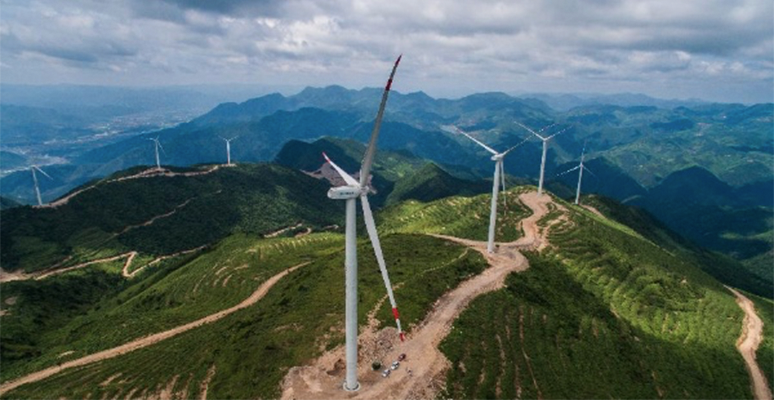
China is heavily investing in technologies for the future across all spectrums of industry – from renewable energy, medical advancements to transportation. Imperial Tours has collected a roster of experts to showcase the dynamic transitions China is making as a global player. We can arrange for you to meet these experts to discuss and learn about China’s political and economic strategies and investments in technology.
The Year of the Rooster
Chinese New Year, also referred to as Lunar New Year and Spring Festival, is the biggest and most important holiday in China. In terms of significance in Chinese culture the Lunar New Year is comparable to combining Thanksgiving and Christmas together. We have assembled some traditions and facts behind one of the world’s largest celebrations to provide a better understanding of this holiday. We have also put together some useful travel tips should you wish to experience this festival first hand.
The tradition of Chinese New Year is said to have started thousands of years ago when, at the end of a cold and hard winter, a mythical beast called Nian would storm into Chinese villages and devour all the men, women and children residing there. Full of fear and with no means to defend themselves the villagers would hide in the surrounding bamboo forests to wait out the night and the wrath of the beast. Until one year, tired of hiding, a brave old man decided to face the beast alone. In preparation for his fateful encounter, the old man hung up red flags and banners; he then cut fresh bamboo to light a fire. Once on fire the green bamboo created such loud cracking sounds that the monster, upon hearing the noise and seeing the many red colors, was scared away. And so as legend goes, from that day on people no longer had to fear the beast. Advancing forward thousands of years, it is now tradition that at the end of winter people across China gather together to celebrate, hang red banners and lanterns, wear red clothing and light firecrackers.
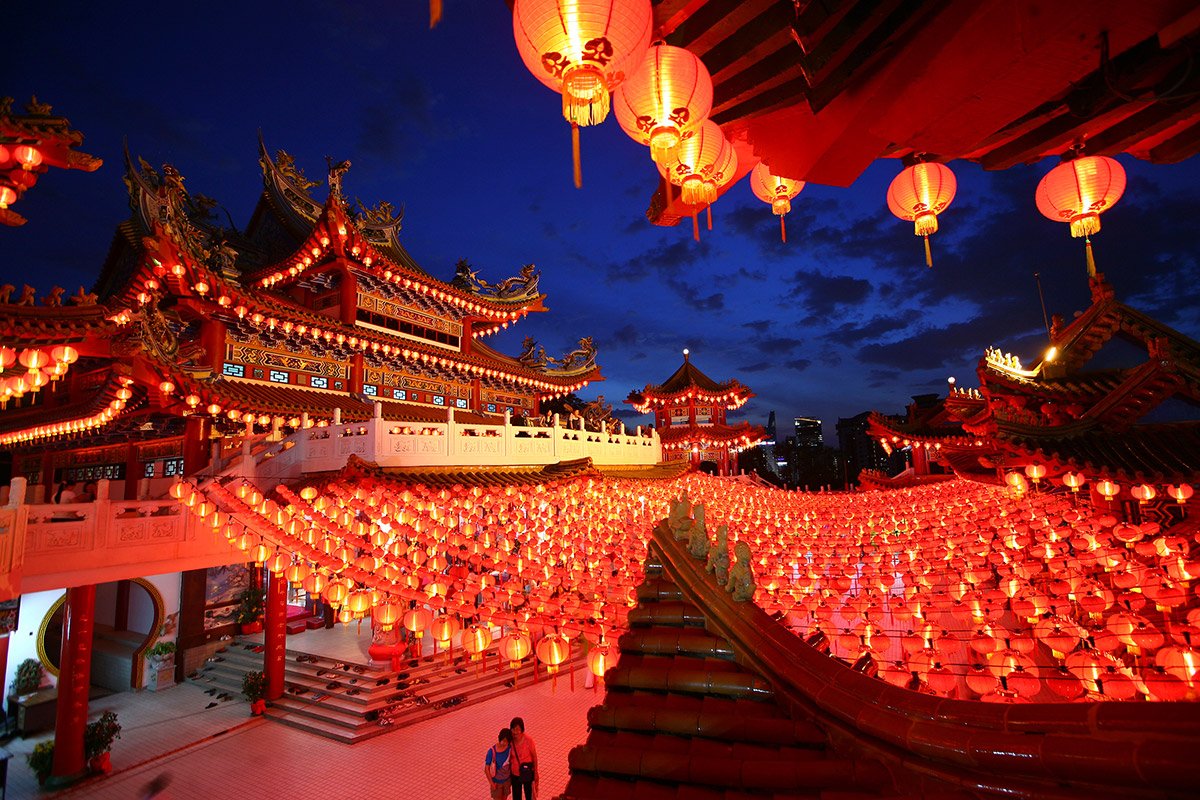
Red Lanterns in Beijing at Chinese New Year/span>
Chinese New Year is a 15-day celebration following the lunar calendar, this means that the date of the holiday changes each year. Generally, Chinese New Year falls between the end of January and the beginning of February. In 2017, January 28th was the first day of the New Year, marking the beginning of the year of the Rooster. Outside China countries such as Indonesia, Malaysia, South Korea, Taiwan and Singapore also recognize and celebrate the festival. Chinese New Year is actually the biggest migration on earth. Over the holiday there are an estimated 650 million people traveling, either throughout China or overseas to visit friends and family. Much like Christmas and Thanksgiving, in Chinese culture over the Lunar New Year it is customary for families to spend time together. For those individuals who have have moved into bigger centers, such as Beijing or Shanghai for work or study, the New Year festival is a time to travel home. For many people, this is the only time of year when they will have time to reunite with their families. Officially, this mass migration begins two weeks before New Years Eve and ends two weeks after; this transport period is referred to as Chun Yun. The Chinese New Year festival is also responsible for the largest television broadcast in the world. Since 1983, CCTV (China Central Television broadcasting company) has hosted a lavish six-hour Spring Festival Gala. The gala is called Chun Wan and is essentially a variety show featuring traditional Chinese performances showcasing China’s vast culture and history. With approximately 800 million viewers, this is the largest entertainment show broadcast globally. Since its origin, Chinese New Year has evolved to incorporate new customs and traditions, which can vary from place to place and family to family. However there are some universal traditions that the majority of those celebrating Chinese New Year recognize. We have created a list of seven common customs followed during the New Year festival.
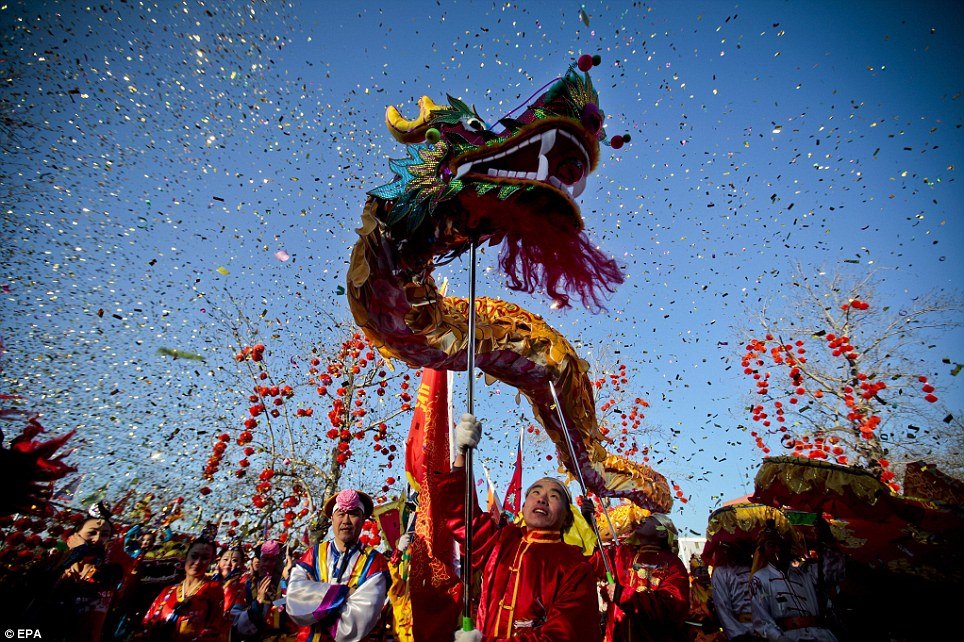
Traditional Chinese New Year Customs
Spring-Cleaning
Several days before the Lunar New Year is set to commence it is customary to perform a spring-cleaning of your home to sweep any ill fortune away. This is also the time to stock up on snacks and food to prepare for the festivities, much like what happens in the days prior to Christmas. This preparation is important as during Chinese New Year it is believed that one should do as little work as possible. It is also considered bad luck to use a knife, light a fire or even use a broom on the first day of the New Lunar Year.
Traditional Red Clothing & Decorations
In line with tradition, at Chinese New Year it is customary to decorate your home with traditional red lanterns and red banners. Across China red banners with auspicious poems written on them are hung outside doors to bring good fortune, wealth, happiness and longevity. In ancient China, New Year was also typically the time when people bought or traded for new clothing. In present-day China, it is customary to buy and wear red clothing, even underwear during this period.
Family Gatherings
It is traditional on New Years Eve for the family to congregate at the husband’s family home, then, on the second day of the New Year, the family would go to their maternal relatives for a visit and celebration. However, during the Lunar Festival the theme is generally ‘the more the merrier’ and generally distant relatives will gather together to celebrate regardless of family ties.
Lucky Foods
Symbolism in China is of utmost importance; even the food that is served and consumed during the New Year festival holds significance. Traditionally, fish is eaten for the New Year’s meal. In Chinese the word fish (yú) sounds similar to the Chinese word for ‘surplus’. Fish is consumed to ensure that each year there will be surplus. However, the fish is never eaten completely as this again symbolizes surplus. Other ‘lucky’ foods include mandarin oranges (júzi) as their name is a homophone of the word for success in Chinese. Another popular food with homophonic meaning is Niangao or glutinous rice cake, which sounds like ‘a more prosperous year’. Additionally, spring rolls and dumplings are eaten because of their similarities to ancient Chinese silver and gold ingots.
Firework Displays
In line with the tradition to scare away the Nian, at midnight on New Years Eve, to ring in the New Year people all over China go outside to set off a barrage of firecrackers and fireworks. However, this practice is not restricted to New Years Eve alone, every night for the next two weeks fireworks are lit until the last day of the festivities when anything that is left is set off.
Temple Visits & Temple Fairs
After the festivities and fireworks the night before, on the morning of New Years Day people congregate at Buddhist temples to give their offerings to the gods. While not everyone in China practices Buddhism, many Buddhist traditions have intermixed with folk customs and it is customary to burn incense at the temples as well as make a donation to wish for a smooth and successful next year. This is often combined with a visit to a traditional temple fair.
Traditional Gifts The five days following New Year’s Day are dedicated to eating, drinking, visiting relatives and playing mahjong. During this time it is traditional for older relatives to give children gifts of red envelopes with money called Hong Bao. The values vary from family to family, but typically Hong Bao’s consist of monetary values containing lucky numbers such as 6, 8 or 9. With the advancement of technology it has now also become popular for friends and family to send each other Hong Bao’s over the messaging service Wechat.
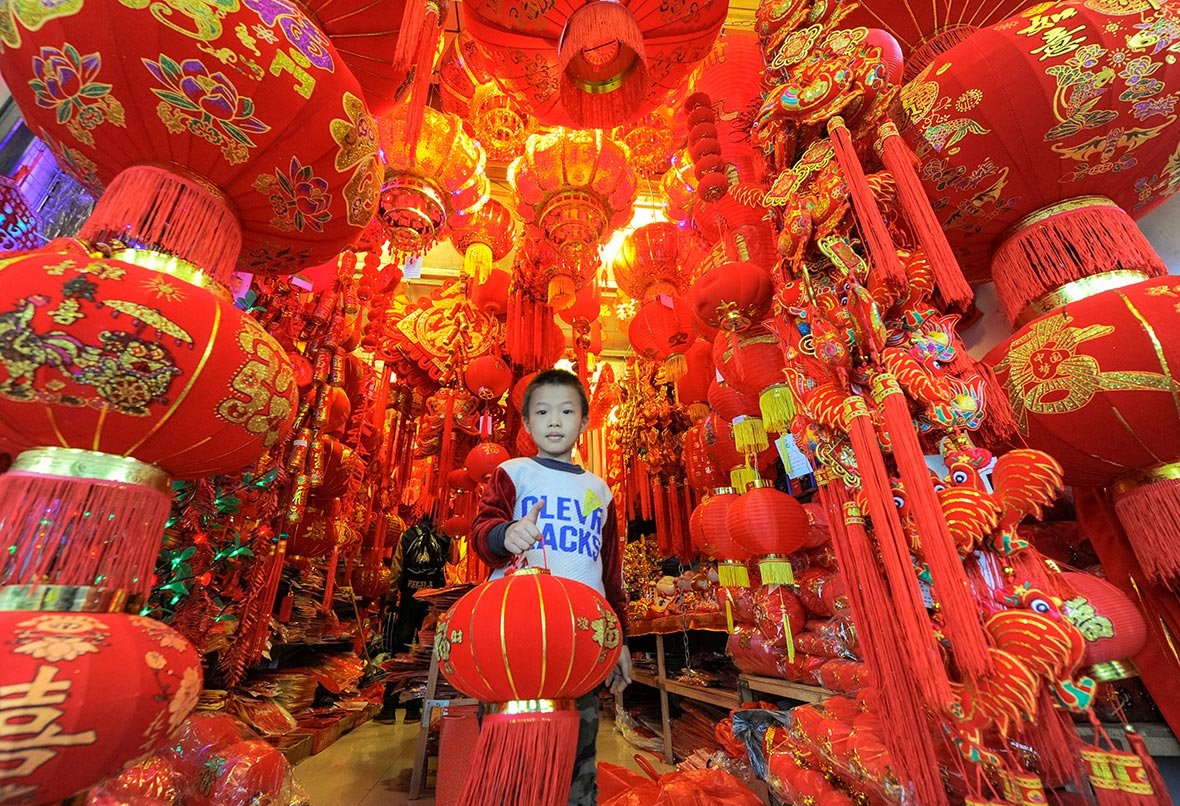
Traveling During the Chinese New Year Festival
Because most businesses are closed for the holiday, we do no recommend traveling during the first week of Chinese New Year. However, in the second week business starts to picks up again, as people return from their holidays the hustle and bustle of modern China slowly returns. If you do wish to come during this period there are some fun and cultural experiences we recommend doing.
Attend a Temple Fair
Visiting a Chinese New Year Temple Fair, called a Miao Hui, is a great way to experience Chinese culture around the Spring Festival. These temple fairs are set up in large city parks and feature arts and crafts as well as traditional performances. Many temple fairs have evolved into bazaar-like events with parts of the park dedicated to arcades where one can try one’s luck at winning an oversized teddy bear and various other prizes. These fairs are also great for trying a multitude of traditional Chinese snacks that are often only available during Chinese New Year.
Fireworks
Over 2,000 years ago China invented fireworks, so it is no surprise that watching and lighting fireworks during the New Year festival can be quite inspirational. On every large street corner temporary shops set up selling boxes of fireworks of various types. During the festival you can expect to see firework displays every evening. In recent years the government has tried to discourage citizens from lighting fireworks in the city due to fire hazards, but this rule goes largely ignored and is often not enforced.
Chinese Zodiac Animals
|
|
Characteristics |
Years |
|
Rat |
Intelligent, adaptable, quick-witted, charming, artistic & sociable. |
2020, 2008, 1996, 1984, 1972, 1960, 1948 & 1936 |
|
Ox |
Loyal, reliable, thorough, strong, reasonable, steady & determined. |
2021, 2009, 1997, 1985, 1973, 1961, 1949 & 1937 |
|
Tiger |
Enthusiastic, courageous, ambitious, leadership, confidence & charismatic. |
2022, 2010, 1998, 1986, 1974, 1962, 1950 & 1938 |
|
Rabbit |
Trustworthy, empathic, modest, diplomatic, sincere, sociable & caretakers. |
2023, 2011, 1999, 1987, 1975, 1963, 1951 & 1939 |
|
Dragon |
Lucky, flexible, eccentric, imaginative, artistic, spiritual & charismatic. |
2024, 2012, 2000, 1988, 1976, 1964, 1952 & 1940 |
|
Snake |
Philosophical, organised, intelligent, intuitive, elegant, attentive & decisive. |
2025, 2013, 2001, 1989, 1977, 1965, 1953 & 1941 |
|
Horse |
Adaptable, loyal, courageous, ambitious, intelligent, adventurous & strong. |
2026, 2014, 2002, 1990, 1978, 1966, 1954 & 1942 |
|
Sheep |
Tasteful, crafty, warm, elegant, charming, intuitive, sensitive & calm. |
2027, 2015, 2003, 1991, 1979, 1967, 1955 & 1943 |
|
Monkey |
Quick-witted, charming, lucky, adaptable, bright, versatile, lively & smart. |
2028, 2016, 2004, 1992, 1980, 1968, 1956 & 1944 |
|
Rooster |
Honest, energetic, intelligent, flamboyant, flexible, diverse & confident. |
2029, 2017, 2005, 1993, 1981, 1969, 1957 & 1945 |
|
Dog |
Loyal, sociable, courageous, diligent, steady, lively, adaptable & smart. |
2030, 2018, 2006, 1994, 1982, 1970, 1958 & 1946 |
|
Pig |
Honorable, philanthropic, determined, optimistic, sincere &sociable. |
2031, 2019, 2007, 1995, 1983, 1971, 1959 &1947 |
Ever wished you could capture images of local life on your travels like these? It may take years to become a professional photographer but you can snap life in the hutongs of Beijing in just an afternoon, especially if you have a great local guide…
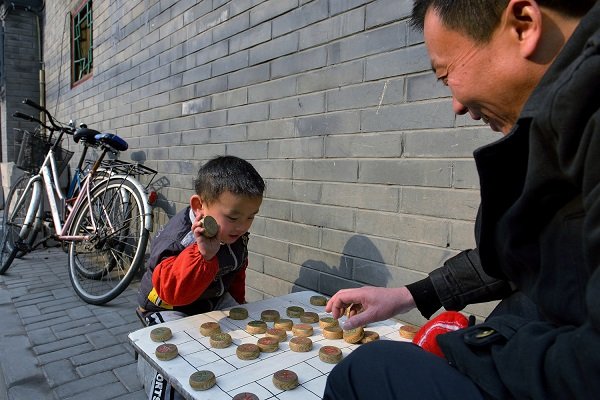
Father and son play a game of Chinese chess
Someone like Matthew Kelly, for example, who has been living and photographing hutong life in Beijing for more than 8 years. He calls himself the ‘people photographer’ as he knows the locals and local lanes or hutongs like the back of his hand. He’ll take you on a trip to find the best subjects and local scenery for you to capture, giving you tips along the way based on his 35 years as a professional photographer.
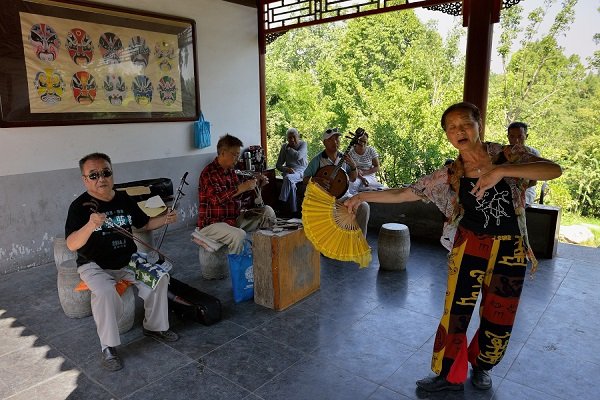
Locals practice opera in Jingshan park near the Forbidden City
The hutong or narrow lanes of old Beijing have existed for over seven hundred years since the Mongol Yuan dynasty (1271 – 1368) chose to install its capital in Beijing. Most of the hutongs in existence today date from the last few centuries. This is where you can witness the daily routines of Chinese life.
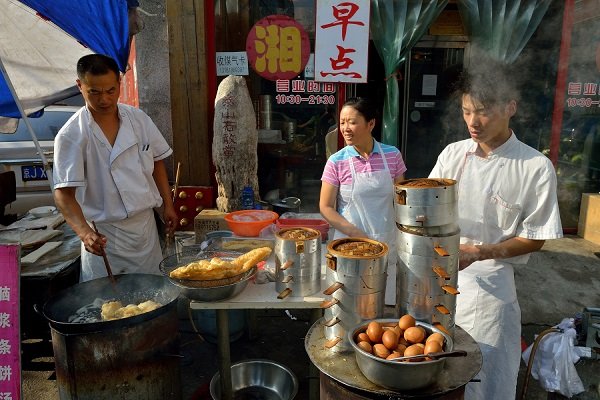
Breakast vendors in the hutongs, a common sight from 4am – 10am
Barbers cut hair out on the streets, women practice traditional dances with fans, men play mahjong or Chinese chess outside their homes, hawkers trundle their carts along the street. Since many people’s hutong houses or siheyuan (courtyards) are so small people live their lives out on the streets, especially during the warmer months from April to October.
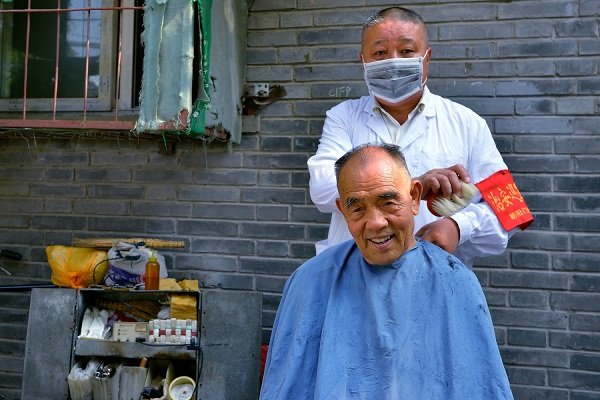
A local street barber at work in the hutongs, not such a common sight as a decade ago
The fascinating local culture is not confined to the hutongs. Matthew can take you to Beijing’s parks where people gather to socialize, dance, sing, play instruments, fly kites, practice martial arts or play games.
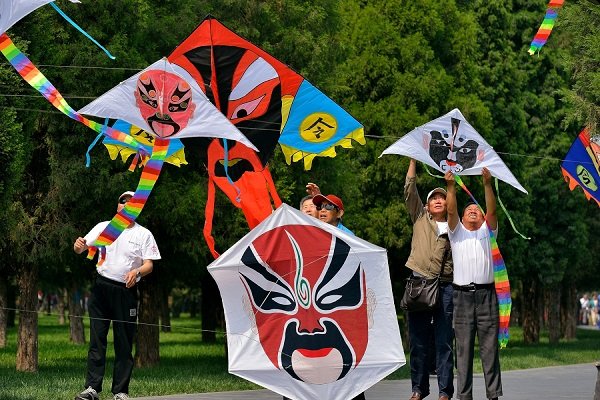
Gentlemen flying traditional kites in Tiantan park
The best parks for this are Jingshan park north of the Forbidden City, Beihai park to the west of Jingshan park, and Tiantan park surrounding the Temple of Heaven.

Posing for photos in traditional dress, a popular thing to do at Beijing’s parks and attractions
To arrange a hutong and / or park photography tour of Beijing just let your itinerary designer know, or if you haven’t started planning an itinerary yet then you can do so here.
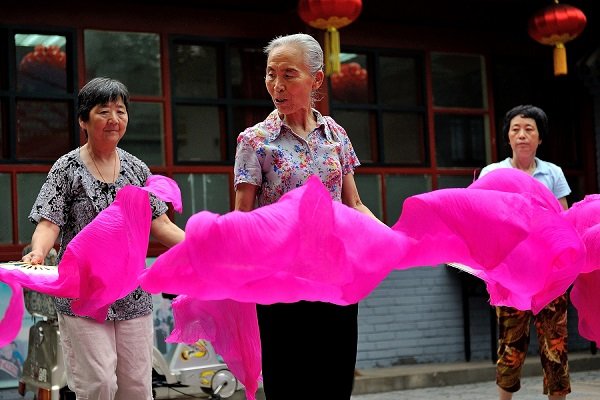
Women practicing fan dancing in the hutongs
All photos are courtesy of Matthew Kelly.